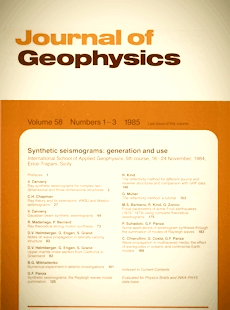Notes on wave propagation in laterally varying structure
Article Sidebar

Vols. 1-18 (1924-1944), ISSN 0044-2801
Main Article Content
Abstract
Recent models of Earth structure suggest large horizontal gradients, especially in shear velocities. Some changes in existing methods are required to construct synthetics for broadband signals in many situations, especially when energy can reach the receiver by up-going as well as down-going paths. This can be accomplished by allowing locally dipping structure and making some modifications to generalized ray theory. Local ray parameters are expressed in terms of a global reference which allows a de Hoop contour to be constructed for each generalized ray with the usual application of the Cagniard-de Hoop technique. Several useful approximations of ray expansions and WKBJ theory are presented. Comparisons of the synthetics produced by these two basic techniques alone, or in combination with known solutions, demonstrates their reliability and limitations.
 ARK: https://n2t.net/ark:/88439/y018295
ARK: https://n2t.net/ark:/88439/y018295
Permalink: https://geophysicsjournal.com/article/231
Article Details
References
Apsel, R.J., Luco, J.E. (1983) On the Green's functions for a layered halfspace, Part II. Bull. Seismol. Soc. Am. 73:931-952
Burdick, L.J., Orcutt, J.A. (1978) A comparison of the generalized ray and reflectivity methods of waveform synthesis. Geophys. J. R. Astron. Soc. 58:261
Červeny, V., Popov, M.M., Psencik, I. (1982) Computation of seismic wave fields in inhomogeneous media, Gaussian beam approach. Geophys. J. R. Astron. Soc. 70:109-128
Chapman, C.H. (1976) A first-motion alternative to geometrical ray theory. Geophys. Res. Letts. 3:153-156
Chapman, C.H. (1978) A new method for computing synthetic seismograms. Geophys. J. R. Astron. Soc. 54:481-518
Chapman, C.H., Drummond, R. (1982) Body-wave seismograms in inhomogeneous media using Maslov Asymptotic Theory. Bull. Seismol. Soc. Am. 72:277-318
Forsyth, D.W. (1975) The early structural evolution and anisotropy of the oceanic upper-mantle. Geophys. J. R. Astron Soc. 43:103-162
Frazer, L.N., Phinney, R.A. (1980) The theory of finite frequency synthetic seismograms in inhomogeneous elastic media. Geophys. J. R. Astron. Soc. 63:691-717
Gilbert, F., Knopoff L. (1961) The directivity problem for a buried line source. Geophysics 26:626-634
Given, J. (1984) Inversion of body-wave seismograms for upper mantle structure. Ph.D. Thesis, California Institute of Technology, Pasadena, California
Grand, S.P., Helmberger, D.V. (1984a) Upper mantle shear structure beneath the northwest Altantic Ocean. J. Geophys. Res. 89:11465-11475
Grand, S.P., Helmberger, D.V. (1984b) Upper mantle shear structure of North America. Geophys. J. R. Astron. Soc. 76:399-438
Helmberger, D.V. (1973) Numerical seismograms of long-period body waves from seventeen to forty degrees. Bull. Seismol. Soc. Am. 63:633-646
Helmberger, D.V. (1983) Theory and Application of Synthetic Seismograms. Proceedings of the International School of Physics, Course LXXXV, H. Kanamori and E. Boschi, eds. North Holland Press
Helmberger, D., Malone, S. (1975) Modeling local earthquakes as shear dislocations in a layered half space. J. Geophys. Res. 80:4881-4888
Hong, T.L., Helmberger D.V. (1977) Generalized ray theory for dipping structure, Bull. Seismol. Soc. Am. 67:995-1008
Hong, T.L., Helmberger D.V. (1978) Glorified optics and wave propagation in non-planar structure. Bull. Seismol. Soc. Am. 68:1313-1330
Hudson, J.A. (1983) SH waves in a wedged-shaped medium. Geophys. J. R. Astron. Soc. 7:517-546
Madariaga, R., Papadimitriou, P. (1984) Gaussian beam modeling of upper mantle phases, submitted to Annales Geophysicae
Muller, G. (1971) Approximate treatment of elastic body waves in media with spherical symmetry. Geophys. J. R. Astron. Soc. 23:435-449
Vidale, J., Helmberger D.V., Clayton, R.W. (1984) Finite-difference seismogram for SH-waves. Bull. Seismol. Soc. Am. (In press)
Wesson, R.L. (1970) A time integration method for computation of the intensities of seismic rays. Bull. Seismol. Soc. Am. 60:307-316
Wiggins, R.A. (1976) Body wave amplitude calculations, II. Geophys. J. R. Astron. Soc. 46:1-10











